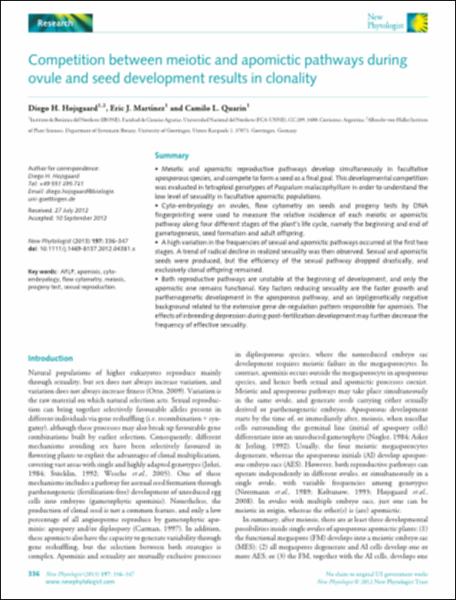Mostrar el registro sencillo del ítem
Competition between meiotic and apomictic pathways during ovule and seed development results in clonality
| dc.contributor.author | Hojsgaard, Diego Hernán | |
| dc.contributor.author | Martínez, Eric Javier | |
| dc.contributor.author | Quarin, Camilo Luis | |
| dc.date.accessioned | 2022-04-21T13:09:54Z | |
| dc.date.available | 2022-04-21T13:09:54Z | |
| dc.date.issued | 2013-01 | |
| dc.identifier.citation | Hojsgaard, Diego Hernán, Martínez, Eric Javier y Quarin, Camilo Luis, 2013. Competition between meiotic and apomictic pathways during ovule and seed development results in clonality. New Phytologist. Londres: Wiley, vol. 197, no. 1, p. 336-347. ISSN-e 1469-8137. | es |
| dc.identifier.uri | http://repositorio.unne.edu.ar/handle/123456789/37737 | |
| dc.description.abstract | Meiotic and apomictic reproductive pathways develop simultaneously in facultative aposporous species, and compete to form a seed as a final goal. This developmental competition was evaluated in tetraploid genotypes of Paspalum malacophyllum in order to understand the low level of sexuality in facultative apomictic populations. Cyto-embryology on ovules, flow cytometry on seeds and progeny tests by DNA fingerprinting were used to measure the relative incidence of each meiotic or apomictic pathway along four different stages of the plant’s life cycle, namely the beginning and end of gametogenesis, seed formation and adult offspring. A high variation in the frequencies of sexual and apomictic pathways occurred at the first two stages. A trend of radical decline in realized sexuality was then observed. Sexual and apomictic seeds were produced, but the efficiency of the sexual pathway dropped drastically, and exclusively clonal offspring remained. Both reproductive pathways are unstable at the beginning of development, and only the apomictic one remains functional. Key factors reducing sexuality are the faster growth and parthenogenetic development in the aposporous pathway, and an (epi)genetically negative background related to the extensive gene de-regulation pattern responsible for apomixis. The effects of inbreeding depression during post-fertilization development may further decrease the frequency of effective sexuality. | es |
| dc.format | application/pdf | es |
| dc.language.iso | eng | es |
| dc.publisher | Wiley | es |
| dc.relation.uri | https://nph.onlinelibrary.wiley.com/doi/epdf/10.1111/j.1469-8137.2012.04381.x | |
| dc.rights | openAccess | es |
| dc.rights.uri | http://creativecommons.org/licenses/by-nc-nd/2.5/ar/ | es |
| dc.source | New Phytologist, 2013, vol. 197, no. 1, p. 336-347. | es |
| dc.subject | AFLP | es |
| dc.subject | Apomixis | es |
| dc.subject | Cytoembryology | es |
| dc.subject | Flow cytometry | es |
| dc.subject | Meiosis | es |
| dc.subject | Progeny test | es |
| dc.subject | Sexual reproduction | es |
| dc.title | Competition between meiotic and apomictic pathways during ovule and seed development results in clonality | es |
| dc.type | Artículo | es |
| unne.affiliation | Fil: Hojsgaard, Diego Hernán. Universidad Nacional del Nordeste. Facultad de Ciencias Agrarias; Argentina. | es |
| unne.affiliation | Fil: Hojsgaard, Diego Hernán. Universidad de Gotinga. Departamento de Botánica Sistemática; Alemania. | es |
| unne.affiliation | Fil: Martínez, Eric Javier. Universidad Nacional del Nordeste. Facultad de Ciencias Agrarias; Argentina. | es |
| unne.affiliation | Fil: Quarin, Camilo Luis. Universidad Nacional del Nordeste. Facultad de Ciencias Agrarias; Argentina. | es |
| unne.journal.pais | Reino Unido | es |
| unne.journal.ciudad | Londres | es |
| unne.ISSN-e | 1469-8137 | es |
Ficheros en el ítem
Este ítem aparece en la(s) siguiente(s) colección(ones)
-
Artículos de revista [535]










